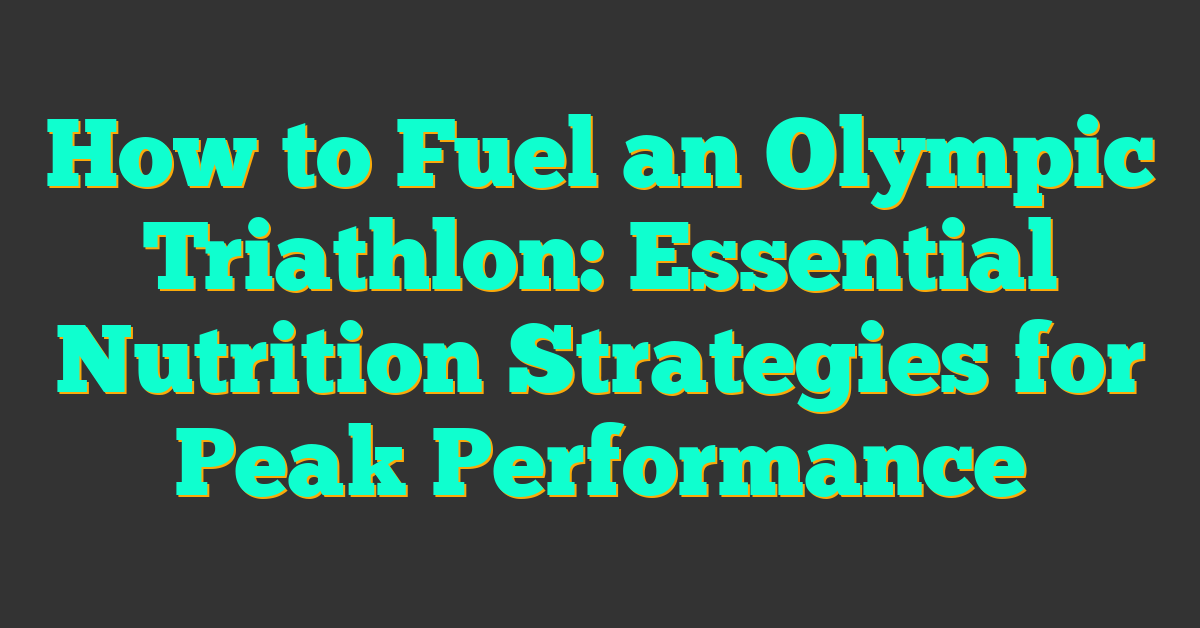Training for an Olympic triathlon is no small feat. Balancing swimming, biking, and running demands not just physical strength but also smart fueling strategies. I’ve learned that what you eat can make or break your performance on race day.

Finding the right balance of nutrients helps sustain energy levels and aids in recovery. From pre-race meals to what you consume during the event, each choice plays a crucial role. Let me walk you through some of the best practices to keep you energized and strong throughout your Olympic triathlon journey.
Understanding the Olympic Triathlon
An Olympic triathlon consists of three disciplines: swimming, biking, and running. Each segment has specific distance requirements that test an athlete’s endurance and versatility.
Distances
| Discipline | Distance |
|---|---|
| Swim | 1.5 kilometers |
| Bike | 40 kilometers |
| Run | 10 kilometers |
These distances are standardized for Olympic competitions, ensuring a consistent challenge for all participants.
Race Structure
I find that the Olympic triathlon follows a sequential order:
- Swim: Starts with the swim segment, typically in open water like a lake or ocean.
- Transition 1 (T1): Quickly switch from swimming to biking, changing gear efficiently.
- Bike: Ride the bike leg, managing pacing and energy conservation.
- Transition 2 (T2): Transition from biking to running, swapping equipment swiftly.
- Run: Finish strong with the run segment, maintaining momentum to the finish line.
Key Considerations
Understanding the race structure helps in planning effective training and nutrition strategies. Each discipline requires specific energy management to ensure peak performance throughout the event.
Importance of Proper Nutrition
Maintaining proper nutrition is crucial for optimizing performance in an Olympic triathlon. It directly influences energy levels, muscle function, and recovery, ensuring that I stay strong and resilient throughout the race.
- Sustained Energy: Consuming the right balance of carbohydrates provides the necessary fuel to maintain endurance during swimming, biking, and running segments.
- Muscle Function: Adequate protein intake supports muscle repair and reduces the risk of fatigue, enabling consistent performance across all disciplines.
- Hydration Balance: Proper fluid intake regulates body temperature and prevents dehydration, which can impair physical and mental functions.
- Recovery Support: Nutrient-rich meals post-training accelerate recovery, allowing me to train effectively without prolonged downtime.
- Performance Optimization: Vitamins and minerals enhance overall bodily functions, contributing to better coordination, strength, and stamina during the triathlon.
By prioritizing these nutritional aspects, I ensure that my body operates at its best, significantly improving my chances of achieving a strong finish in the Olympic triathlon.
Pre-Race Nutrition
Proper pre-race nutrition sets the foundation for my performance. I implement targeted strategies to optimize energy and hydration levels.
Carbohydrate Loading
I increase my carbohydrate intake to 7-10 grams per kilogram of body weight in the three days before the race. This strategy fills my glycogen stores, ensuring I have sustained energy for swimming, biking, and running. Foods like pasta, rice, and sweet potatoes become my go-to choices, providing the necessary fuel for endurance.
Hydration Strategies
Staying hydrated is essential for peak performance. I start by drinking at least 3 liters of water each day leading up to the race. On race morning, I consume 500 milliliters of water or an electrolyte-rich drink two hours before the start. During the triathlon, I take small sips regularly at hydration stations to maintain my fluid and electrolyte balance, preventing dehydration and cramps.
During the Race Nutrition
Maintaining energy and electrolyte levels sustains performance throughout the triathlon. I implement strategies to ensure consistent energy supply and prevent dehydration.
Energy Gel Usage
I use energy gels to replenish carbohydrates during the race. Consuming one gel every 45 minutes provides about 20-25 grams of carbohydrates. Preferred brands include GU, Clif, and Honey Stinger, offering various flavors for taste preference. Pairing gels with water enhances absorption and energy delivery.
| Time Interval | Energy Gel Consumption | Carbohydrates (grams) |
|---|---|---|
| Every 45 minutes | 1 gel | 20-25 |
Electrolyte Replacement
Replenishing electrolytes prevents muscle cramps and maintains hydration. I drink electrolyte-rich beverages at each hydration station, targeting sodium and potassium balance. Typically, I consume 500 milliliters of a sports drink every hour. Additionally, I use electrolyte tablets as needed to maintain optimal levels.
| Electrolyte Source | Quantity |
|---|---|
| Sports Drink (e.g., Gatorade) | 500 ml per hour |
| Electrolyte Tablets | As needed |
Post-Race Recovery Nutrition
After crossing the finish line, proper nutrition kickstarts your recovery process.
Protein Intake
I aim for 20-30 grams of protein within 30 minutes post-race to repair muscle fibers. Lean meats like chicken and turkey, along with plant-based sources such as tofu and legumes, are my go-to options. Protein shakes or bars provide a convenient way to ensure I meet my protein needs quickly.
Rehydration Techniques
Rehydrating effectively means replacing lost fluids and electrolytes. I typically drink 1-1.5 liters of water immediately after the race. Additionally, electrolyte-rich beverages like sports drinks or coconut water help restore sodium and potassium levels. Consuming foods with high water content, such as fruits and vegetables, also supports hydration.
Sample Nutrition Plan
Three Days Before the Race
| Meal | Time | Foods | Notes |
|---|---|---|---|
| Breakfast | 7:00 AM | Oatmeal with banana slices and honey | High in carbohydrates for energy |
| Snack | 10:00 AM | Greek yogurt with mixed berries | Provides protein and antioxidants |
| Lunch | 1:00 PM | Grilled chicken breast, quinoa, steamed vegetables | Balanced meal with protein and carbs |
| Snack | 4:00 PM | Whole grain toast with almond butter | Sustained energy from healthy fats |
| Dinner | 7:00 PM | Spaghetti with marinara sauce and lean ground turkey | Carbohydrate loading for glycogen stores |
| Hydration | Throughout | 3 liters of water daily | Maintain optimal hydration levels |
Race Day
| Time | Meal/Snack | Foods | Notes |
|---|---|---|---|
| Morning | Breakfast (3 hours before) | Bagel with peanut butter and a banana | Easily digestible carbohydrates and protein |
| Pre-Race | 2 hours before | 500 ml of electrolyte-rich drink | Ensure proper hydration and electrolyte balance |
| During Race | Every 45 minutes | 1 energy gel with water (e.g., GU, Clif) | Maintain energy levels and carbohydrate intake |
| Mid-Race | As needed | Electrolyte tablets | Prevent muscle cramps by replacing electrolytes |
| Post-Race | Immediately after | Protein shake with 25 grams of protein | Kickstart muscle recovery |
| Post-Race | Within 30 minutes | 1-1.5 liters of water and sports drink | Rehydrate and restore electrolyte balance |
| Recovery | 1 hour after | Grilled salmon, sweet potatoes, and steamed broccoli | Balanced meal with protein, carbs, and nutrients |
Training Days
| Meal | Time | Foods | Notes |
|---|---|---|---|
| Breakfast | 7:00 AM | Scrambled eggs, whole grain toast, and avocado | Protein and healthy fats for sustained energy |
| Snack | 10:00 AM | Apple slices with peanut butter | Quick energy and protein boost |
| Lunch | 1:00 PM | Turkey and cheese wrap with mixed greens | Balanced intake of protein and vegetables |
| Snack | 4:00 PM | Trail mix with nuts, dried fruits, and seeds | Provides a mix of carbohydrates and fats |
| Dinner | 7:00 PM | Baked chicken, brown rice, and roasted vegetables | Supports muscle recovery and energy replenishment |
| Hydration | Throughout | 3 liters of water daily | Maintain hydration for optimal performance |
This sample nutrition plan outlines specific meals and snacks with corresponding times and food choices to optimize energy, hydration, and recovery before, during, and after an Olympic triathlon. Adjust portion sizes based on individual body weight and energy needs to ensure effective fueling.
Conclusion
Training for an Olympic triathlon is a rewarding journey. I’ve found that paying attention to fueling strategies makes all the difference on race day. By staying consistent with your nutrition and hydration, you set yourself up for success. Embrace the process and trust your preparation. Remember, every meal and every sip plays a part in your performance. Stay positive and listen to your body throughout your training. With the right approach, you’ll maintain your energy and recover effectively. I’ll be cheering you on as you cross that finish line strong!










